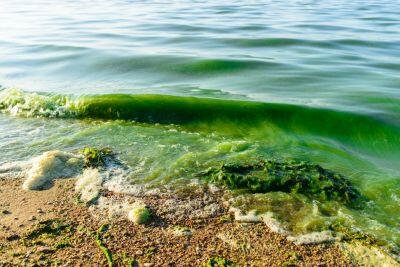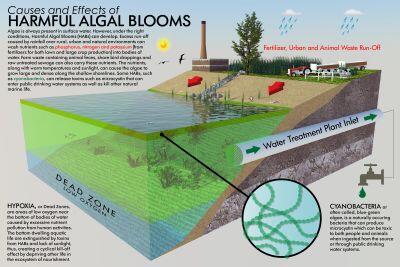NATIONAL POND SERVICE – EDUCATIONAL RESOURCES
Harmful Algae Blooms & Cyanobacteria Photosynthesis
Harmful Algal Blooms & Cyanobacteria: What Are They?
Harmful algal blooms (HABs) are blue-green algae blooms that may adversely affect humans, animals, and the environment. Blooms typically occur during the warm-weather months of June through September. Blooms may appear as a thick scum layer or green paint on the surface of the water, and can be a variety of colors such as blue, green, or brown. There may also be a foul odor present during a bloom, especially during the warm summer months.
Blue-green algae, or cyanobacteria, are photosynthetic bacteria that are a natural part of the aquatic environment. Blue-green algae are often present in lakes in small or moderate amounts, but can grow and proliferate quickly in warm, fresh water that is rich with nutrients (like nitrogen and phosphorous). This sudden, rapid growth is referred to as an algal “bloom.”
Harmful algal blooms have been a big issue in the Finger Lakes over the past several years. In 2017, all eleven of the Finger Lakes appeared on the NYS DEC Harmful Algal Bloom notification page. In freshwater, Harmful Algal Blooms are generally caused by cynobacteria, which are commonly referred to as blue-green algae.
What are Cyanobacteria?
Cyanobacteria are a type of bacteria capable of photosynthesis. Although they are not true algae, in the past they were referred to as “blue‐green algae” in the past. Cyanobacteria frequently impart off‐tastes and odors to the water in which they grow, and sometimes they produce toxins that can be harmful to the health of humans and other animals. Although problems related to cyanobacteria most often occur in freshwaters (lakes and streams), cyanobacteria can also be found in marine waters.
Cyanobacteria are a group of bacteria that rely on photosynthesis for their energy. They are often confused with algae even though they are unrelated to algae. Cyanobacteria are common organisms that are always present in ponds and lakes. Many types of cyanobacteria are able to fix atmospheric nitrogen, so they have an advantage over other aquatic microflora when nitrogen is the limiting nutrient. In situations where phosphorous levels are high, nitrogen is usually limiting and populations of cyanobacteria can take off, causing a bloom. A phosphorous/ nitrogen imbalance is the most common cause of a cyanobacterial bloom, but there are other situations that can cause blooms that are poorly understood.
Some types of cyanobacteria can produce toxins, the most commonly detected of these is called microcystin. Microcystin and other toxins caused by cyanobacteria can cause diarrhea, nausea or vomiting, skin, eye or throat irritation, allergic reactions or breathing difficulties they are also known to cause liver damage.
It is difficult to determine if a cyanobacterial bloom contains harmful toxins, so if you see water that might have a bloom, it is best to avoid it. If you come in contact with what you think may be a harmful algal bloom you should first rinse thoroughly with clean water and stop using the suspected water. You should seek medical attention if any symptoms develop. Pets should be kept away from harmful algal blooms.
Because cyanobacteria are nitrogen fixers, they can take advantage of high phosphorous levels and often bloom when there is too much phosphorous in a body of water. Blooms also are more likely to occur in warmer waters. Wind mixes the water which can disrupt the life cycle of cyanobactria, so calm weather also increases the probability of cyanobactrial blooms. Since we have little control over the weather, the best way to reduce the probability of a cyanbacterial bloom is to limit phosphorous levels and, to a more limited degree, nitrogen levels. If you have a pond on your property, you can limit nutrient inputs by limiting lawn fertilization, maintaining septic tanks and shoreline buffers, reducing erosion and stormwater runoff, and maintaining water movement.
Harmful algal blooms (HABs) are caused by cyanobacteria (also known as blue-green algae) which may or may not produce toxins. Cyanobacteria are common single-celled organisms that naturally exist in fresh waters, such as lakes and ponds, or slightly saline waters such as tidal rivers and estuaries (brackish water). The cyanobacteria utilize sunlight and nutrients from the water to grow and multiply. When there are too many nutrients in the water, the bacteria can grow rapidly or “bloom”. Blooms may turn the water a green, red, or brownish color. Blooms may also form a visible scum on the water surface, similar to the look of spilled paint. Blooms are more likely to occur in hot summer months.
The production of toxins is what makes an algal bloom harmful. Microcystin is the most well-known toxin produced during a harmful algal bloom, and it can cause a variety of symptoms by affecting the skin, liver, GI tract, and nervous system. Ingestion, inhalation, or direct contact with contaminated water may cause illness.
What does a Harmful Algae Bloom look like
A cyanobacterial HAB often looks like a layer of bright bluish‐green or white paint on the water surface. It can also appear as yellow, red or brown. Other evidence of a potential cyanobacterial HAB could be discolored or pea‐green colored water, parallel streaks, or green dots/globs in the water. It is important to note that some blooms are due to common green algae and not cyanobacteria and, when present, cyanobacteria do not always produce cyanotoxins.
Cyanobacteria are often confused with green algae. Cyanobacteria can give water a spilled paint appearance, a pea soup appearance, green streaks on the water, or floating dots or clumps. Green algae can form into large, floating mats on the surface of a lake or pond, they can also look like bubbling scum on the water. Green algae can have an unpleasant smell and can look gross, but does not produce harmful toxins.
What causes cyanobacteria to grow?
Certain environmental conditions, such as warm weather, sunlight, excess nutrients, and stagnant/slow-moving waters help cyanobacteria grow faster. Specific factors behind each bloom vary because every waterbody is different. However, two of the most common factors are phosphorus and nitrogen, which are found in fertilizers and human/animal waste.
Are HAB’s Dangerous?
The blue-green algae Microcystis aeruginosa can produce a family of toxins known as microcystins. They can cause liver damage that can lead to death in dogs and livestock. No known deaths have been reported in humans from the ingestion of microcystins. Fish and birds are also at risk for microcystin toxicity. Regardless of species, the mechanism of action is the same – the inhibition of protein phosphatase which causes primarily liver damage, but also affects other organs. Microcystins also act as a tumor promoter.
While microcystins are not as toxic as many natural toxins, they are becoming more and more ubiquitous in California, leading to greater opportunities for exposures. Microcystis blooms occur in quiet, warm waters that are nutrient-rich; the type of conditions that are found in lakes, reservoirs, dammed rivers, and even agricultural drainage ditches throughout the state.



